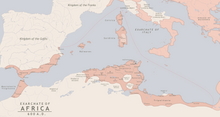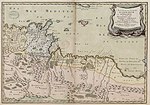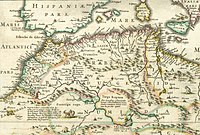
Back Exarchat von Karthago ALS إكسرخسية قرطاج Arabic Exarcáu d'África AST Афрыканскі экзархат Byelorussian Африкански екзархат Bulgarian Exarcat d'Àfrica Catalan Africký exarchát Czech Exarchat von Karthago German Εξαρχάτο της Αφρικής Greek Exarcado de África Spanish
This article needs additional citations for verification. (May 2013) |
| Exarchate of Africa | |||||||||||||
|---|---|---|---|---|---|---|---|---|---|---|---|---|---|
| Exarchate of the Byzantine Empire | |||||||||||||
| 591–698 | |||||||||||||
 Map of the Exarchate of Africa within the Byzantine Empire in AD 600. | |||||||||||||
| Capital | Carthage | ||||||||||||
| Historical era | Late Antiquity to Early Middle Ages | ||||||||||||
• Foundation of Exarchate | 591 | ||||||||||||
• Loss of last outposts in the Iberian Peninsula by the Visigoths | 624 | ||||||||||||
• First Arab invasion | 647 | ||||||||||||
| 698 | |||||||||||||
| |||||||||||||
| History of Tunisia |
|---|
 |
|
|
| History of Algeria |
|---|
 |
The Exarchate of Africa was a division of the Byzantine Empire around Carthage that encompassed its possessions on the Western Mediterranean. Ruled by an exarch (viceroy), it was established by the Emperor Maurice in 591 and survived until the Muslim conquest of the Maghreb in the late 7th century. It was, along with the Exarchate of Ravenna, one of two exarchates established following the western reconquests under Emperor Justinian I to administer the territories more effectively.